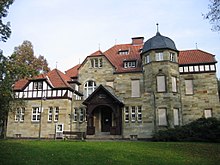The Cologne-Bonn region located in North Rhine-Westphalia. It is at the transition from Medium- to the Lower Rhine and is strongly urban.


Regions
This article describes the core region of the Cologne Bay, including the lower Siegtal. The south-east of the region also belongs to the Cologne / Bonn region in the broader sense Lower Rhine region and parts of the Bergisches Landes, the Jülich-Zülpicher Börde and the Pre-Eifel as well as that Siebengebirge, each of which is presented in its own article.
places
The two eponymous capitals of the metropolitan region:
- Cologne - Metropolis of millions of the Rhineland, known for cathedral, carnival and Kölsch as well as cultural history from Roman times to today
- Bonn - Former seat of government of the Federal Republic, today still seat of ministries, federal authorities and international organizations, traditional university location and birthplace of Beethoven

Also located directly on the Rhine (downstream)
- Niederkassel
- Bornheim
- Wesseling
- Leverkusen - Primarily an industrial location (especially Bayer), known for its football club, but also a cultural location with an important collection of modern art in Morsbroich Castle, and there are also several parks and gardens that are well worth seeing, especially the particularly beautiful Japanese Garden
- Dormagen

Left of the Rhine:
- Bruehl - with the rococo castles of Augustusburg and Falkenlust (world cultural heritage) and Phantasialand
- Huerth
- Cheeky

Lying in the lower Siegtal (downstream)
- Hennef
- Saint Augustine - The city in front of the gates of Bonn, created by the merger of several communities (e.g. Hangelar, Menden, Niederpleis), but a kind of center (Sankt Augustin-Ort) also emerged in the 20th century; several of the districts have an old town center with Rhenish half-timbered houses; there are also the eponymous mission house St. Augustin der Steyler Missionare, the partly Romanesque church of Niederpleis, Birlinghoven Castle and the House of Nations and Cultures
- Siegburg
- Lohmar
- Troisdorf
Neuss is already going to Düsseldorf area counted; Bergisch Gladbach and Overath to the Bergisches Land. The cities in the lower Erft valley (Erftstadt, Kerpen, Bergheim, Bedburg) as Meckenheim and Rheinbach are at the transition from the Cologne-Bonn region to Jülich-Zülpicher Börde.
Other goals

- Rhineland Nature Park, also known as the Kottenforst-Ville Nature Park, west of Cologne and Bonn, with the Villeseen
background
language
High German is spoken, often with a typical Rhenish ("Cologne") coloring, which is often described as "Singsang". Some speakers occasionally use dialect terms, think of “Piesepampel” (bad-tempered contemporary) or “Pittermännchen” (10-liter beer barrel). This is also referred to with the catchphrase "Familienkölsch". The use of real dialects, on the other hand, has declined sharply in everyday life and is mostly only cultivated in the context of traditional events.
getting there

By plane
- The Cologne Bonn Airport is located on the southern outskirts of Cologne, about 16 km north of Bonn.
By train
- ICE node Cologne
- ICE stops Cologne-Bonn Airport and Siegburg / Bonn
mobility
The region has a dense local transport network. Important regional train lines are:
- RE 5, RB 26 or RB 48 from Cologne via Brühl to Bonn and Bad Godesberg
- RE 8 or RB 27 from Cologne via Troisdorf, Bonn-Beuel and Königswinter to Bad Honnef
- RE 9, S 12 or S 19 from Cologne via Troisdorf, Siegburg and Hennef to Au (Sieg)
Lines of the S-Bahn Cologne lead to Troisdorf, Kerpen-Horrem and Leverkusen, among others.
Light rail of the Cologne Transport Company (KVB) drive (via Wesseling or via Hürth, Brühl and Bornheim to Bonn (including Bad Godesberg), Bensberg and Frechen-Benzelrath.
Lines of Bonn tram lead to Sankt Augustin, Siegburg, Königswinter, Bad Honnef and Bornheim
The Cologne-Bonn region is cut through by numerous motorways, but it is also one of the most congested sections of the German motorway network.
Tourist Attractions

Churches and monasteries
- Cologne cathedral (World Heritage)
- St. Michael Abbey in Siegburg
Castles and Palaces
- World Heritage Sites: Rococo Castles Augustusburg and Falkenburg in Bruehl
- Leverkusen: Morsbroich Castle Former moated castle transformed into a rococo castle, now houses the city museum for modern art and is surrounded by a sculpture park
- Kendenich Castle at Huerth
Parks and gardens
- Japanese garden at the city limits Leverkusen and Cologne at Bayerwerk
- City forest Cologne with the forest botanical garden, Cologne, Bruehl (Rhineland), Wesseling
activities

- amusement park Phantasialand
- Water sports, e.g. B.
- Active events Bredthauer, Office: Hauptstrasse 124, 53229 Bonn. Tel.: 49 (0)228 908497 3. Canoe station in Eitorf on the Sieg.
